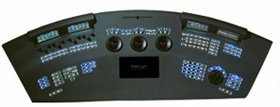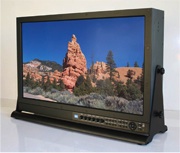[Inter BEE 2009: Highlight Pickup!] Hoei Sangyo Co., Ltd. - Demo exhibit of FilmLight's "Baselight" color grading system
2009.11.6 UP

Hoei Sangyo Co., Ltd. handles a range of new products, some of which are being exhibited.
The main exhibited products are as follows:
FilmLight Baselight non-linear color grading system (new product)
FACILIS TERRABLOCK 24D server-direct SAN system
FOCUS FS-5 compact hard disk recorder
FOCUS Proxsys digital asset management
StorageDNA DNA720 server digital media transfer synchronization system, StorageDNA Syncsy server
Front Porch Digital DIVAsolo ingest/archive solutions (SAMMA Solo, DIVAdirector, DIVArchive (new products))
Pixelmetrix DVStation Series regulated recording system and DVStor (full server & HDD model)
Volicon Observer baseband regulated recording system (server model)
Algolith HD/SD-SDI noise reducer
TAMUZ 32 inch/24 inch high-definition LCD master monitor (new product)
FilmLight's Baselight color grading system will be presented in a demonstration exhibit. Baselight has been exhibited in private exhibits since spring this year, but this is the first time this product has been exhibited in public. In the future, it is likely to garner further attention as digital production process flows that support high-resolution video become even more widespread.
Koji Hidaka, System Sales Chief in the System Sales Department at Hoei Sangyo Co., Ltd. talked about some features of FilmLight's color grading system. "This has an established reputation around the world as a top-class color grading system product. Because it was developed exclusively for color grading, both the hardware and algorithms used in calculations are designed to be optimized for these tasks, and it is capable of processing 2k, 4k, and even 8k high-definition video without trouble. Color grading is essential in the digital video production process, and has a major influence on work efficiency. Being able to carry out color grading processing in a short period of time means an increase the time spent on creative work itself, and it can contribute towards increasing the quality of images, and of the product itself".
"The advantage of supporting incremental system introduction is also a strength. In addition to DPX and R3D, the product also supports a large number of file formats, meaning smooth linkups with other models. We hope to use Inter BEE to show off the usability of our top-range equipment, and its high work efficiency".
FACILIS's TERRABLOCK 24D is a server-direct SAN system that can also be used in client's multiple operating system environments. Already, more than 100 have been sold in Japan. This exhibit will show off version 4.1 which is the latest, and which has an improved file sharing system. Product on display by FOCUS is the FS-5 compact hard disk recorder for use together with video cameras. This can be mounted on an HDV camera, and incorporates IEEE1394 and USB connections. This can record in a format for use with non-linear editing tools, meaning editing work can be started without conversion simply by connecting via USB to a PC.
Other FOCUS products planned for exhibit are the FS-H200 recorder that uses compact flash memory.
"Incorporation with HDV cameras means that obviously, our main target market is industry applications. This product has a long video recording time, with the 100 GB model capable of 7 hours consecutive recording. The standard battery provides 180 minutes recording, but much longer recording is possible when used in conjunction with an AC adapter". (Hidaka)
The Proxsys digital asset management (DAM) system from FOCUS manages data in a file format, and by using thumbnails, simplifies management. Mr. Hidaka stated "Change Proxsys configuration to match user needs is easy, meaning it can be used in many different ways". Using Proxsys to connect together servers on a network with multiple editing or browsing terminals gives a variety of usage scenarios. These include content version management, backup, video-on-demand-type browsing and download services, and content asset management.
One feature is its ability to share content that is on a server on the network, and at the same time, it can backup original and revised versions by reproducing processes such as improvements or additions to content on another terminal. "In particular in production management, the move to file-based archiving means this can be used in a great variety of ways, including in resource management at production companies and broadcasters. The variety of usage methods was simply not possible back when using VTRs". (Hidaka) Front Porch Digital's ingest/archive solutions are very popular amongst broadcasters around the world, where they have become the default for archiving systems. Usage can also be tailored depending on the volume of video assets.
Storage DNA's digital media transfer synchronization system can simplify backups, and was introduced at a demonstration exhibit at Inter BEE last year. The exhibit will show the management status on a PC screen. Its function is to connect between remote servers and multiple terminals to share data, and sharing operations results is also possible.
The VNR-1000-HD noise reducer from Canadian company Algolith is a product that is based upon the Open Gear multi-definition digital frame standards proposed by North American companies. Open Gear features a chassis with a built-in power supply, Ethernet connection, and 10 slots, into which cards incorporating various functions can be inserted. This also supports improvements to functionality and version upgrades, which can be carried out by rewriting the firmware over the network. A shared chassis both increases space efficiency, and reduces costs.
Algolith provides a range of products such as converters, noise reducers, and enhancers that support Open Gear, and this includes the VNR-1000-HD. This can reduce or eliminate types of noise such as mosquito noise and block noise generated in DCT compression, and different noise types resulting from digital conversion.
32-inch and 24-inch high-definition LCD master monitors from German company TAMUZ are the only products that support TECH3220 Grade-1 (master monitor level) recommended specifications for LCD monitors, as proposed by the EBU. At present, Grade-1 master monitors are manufactured by Sony, barco, and TAMUZ, however the only 32-inch monitor to achieve a Grade-1 rating is that from TAMUZ. The 32 inch model supports multiple formats such as 3G-SDI, has brightness of SMPTE (35 fL/120 cd/m), and features contrast of over 2200:1.
Tsutomu Mukai from the System Business Division, Sales Promotion Division Development Group talked about the distinctive features of TAMUZ. "TAMUZ specializes in LCD monitor manufacturer. One of their features is their outstanding engine. Instead of using LEDs in the panels, they use a cathode-ray tube that they developed, and by positioning them in a special location, this provides light quantities and contrast levels sufficient for use as a master monitor on a 32-inch screen.
There were issues regarding contrast and brightness in LCD monitors, but these models have had a major impact in the United States. They have already garnered high praise, even from domestic broadcasters. They have outstanding cost-performance when compared to monitors from other manufacturers. Their pricing is very competitive, at under ¥2,000,000 for the 24 inch model, and around ¥2,500,000 for the 32 inch model. They can also be used in DI workplaces".
The monitors will be demonstrated as a Filmlight monitor at Inter BEE.








